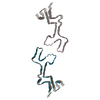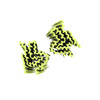+ Open data
Open data
- Basic information
Basic information
| Entry |  | |||||||||||||||
|---|---|---|---|---|---|---|---|---|---|---|---|---|---|---|---|---|
| Title | Lipidic alpha-synuclein fibril - polymorph L2B | |||||||||||||||
 Map data Map data | Lipidic alpha-synuclein fibril - polymorph L2B | |||||||||||||||
 Sample Sample |
| |||||||||||||||
 Keywords Keywords | amyloid fibril / PROTEIN FIBRIL | |||||||||||||||
| Function / homology |  Function and homology information Function and homology informationregulation of phospholipase activity / negative regulation of monooxygenase activity / negative regulation of mitochondrial electron transport, NADH to ubiquinone / positive regulation of glutathione peroxidase activity / neutral lipid metabolic process / regulation of acyl-CoA biosynthetic process / negative regulation of dopamine uptake involved in synaptic transmission / negative regulation of norepinephrine uptake / positive regulation of SNARE complex assembly / positive regulation of hydrogen peroxide catabolic process ...regulation of phospholipase activity / negative regulation of monooxygenase activity / negative regulation of mitochondrial electron transport, NADH to ubiquinone / positive regulation of glutathione peroxidase activity / neutral lipid metabolic process / regulation of acyl-CoA biosynthetic process / negative regulation of dopamine uptake involved in synaptic transmission / negative regulation of norepinephrine uptake / positive regulation of SNARE complex assembly / positive regulation of hydrogen peroxide catabolic process / supramolecular fiber / negative regulation of transporter activity / mitochondrial membrane organization / negative regulation of chaperone-mediated autophagy / regulation of reactive oxygen species biosynthetic process / regulation of synaptic vesicle recycling / negative regulation of platelet-derived growth factor receptor signaling pathway / positive regulation of protein localization to cell periphery / negative regulation of exocytosis / regulation of glutamate secretion / response to iron(II) ion / regulation of norepinephrine uptake / SNARE complex assembly / positive regulation of neurotransmitter secretion / dopamine biosynthetic process / regulation of locomotion / positive regulation of inositol phosphate biosynthetic process / synaptic vesicle priming / regulation of macrophage activation / negative regulation of microtubule polymerization / synaptic vesicle transport / dynein complex binding / dopamine uptake involved in synaptic transmission / positive regulation of receptor recycling / regulation of dopamine secretion / protein kinase inhibitor activity / negative regulation of thrombin-activated receptor signaling pathway / response to type II interferon / cuprous ion binding / response to magnesium ion / positive regulation of exocytosis / synaptic vesicle exocytosis / positive regulation of endocytosis / kinesin binding / cysteine-type endopeptidase inhibitor activity involved in apoptotic process / mitochondrial ATP synthesis coupled electron transport / synaptic vesicle endocytosis / regulation of presynapse assembly / negative regulation of serotonin uptake / alpha-tubulin binding / phospholipid metabolic process / supramolecular fiber organization / axon terminus / inclusion body / cellular response to copper ion / cellular response to epinephrine stimulus / Hsp70 protein binding / response to interleukin-1 / : / adult locomotory behavior / positive regulation of release of sequestered calcium ion into cytosol / SNARE binding / excitatory postsynaptic potential / fatty acid metabolic process / long-term synaptic potentiation / phosphoprotein binding / protein tetramerization / regulation of transmembrane transporter activity / protein destabilization / negative regulation of protein kinase activity / microglial cell activation / synapse organization / regulation of long-term neuronal synaptic plasticity / ferrous iron binding / positive regulation of protein serine/threonine kinase activity / tau protein binding / PKR-mediated signaling / receptor internalization / : / phospholipid binding / synaptic vesicle membrane / positive regulation of inflammatory response / actin cytoskeleton / positive regulation of peptidyl-serine phosphorylation / actin binding / cell cortex / cellular response to oxidative stress / histone binding / growth cone / chemical synaptic transmission / neuron apoptotic process / negative regulation of neuron apoptotic process / postsynapse / response to lipopolysaccharide / amyloid fibril formation / molecular adaptor activity / lysosome / transcription cis-regulatory region binding / oxidoreductase activity / positive regulation of apoptotic process Similarity search - Function | |||||||||||||||
| Biological species |  Homo sapiens (human) Homo sapiens (human) | |||||||||||||||
| Method | helical reconstruction / cryo EM / Resolution: 3.05 Å | |||||||||||||||
 Authors Authors | Frieg B / Antonschmidt L / Dienemann C / Geraets JA / Najbauer EE / Matthes D / de Groot BL / Andreas LB / Becker S / Griesinger C / Schroeder GF | |||||||||||||||
| Funding support |  Germany, 4 items Germany, 4 items
| |||||||||||||||
 Citation Citation |  Journal: Nat Commun / Year: 2022 Journal: Nat Commun / Year: 2022Title: The 3D structure of lipidic fibrils of α-synuclein. Authors: Benedikt Frieg / Leif Antonschmidt / Christian Dienemann / James A Geraets / Eszter E Najbauer / Dirk Matthes / Bert L de Groot / Loren B Andreas / Stefan Becker / Christian Griesinger / Gunnar F Schröder /  Abstract: α-synuclein misfolding and aggregation into fibrils is a common feature of α-synucleinopathies, such as Parkinson's disease, in which α-synuclein fibrils are a characteristic hallmark of neuronal ...α-synuclein misfolding and aggregation into fibrils is a common feature of α-synucleinopathies, such as Parkinson's disease, in which α-synuclein fibrils are a characteristic hallmark of neuronal inclusions called Lewy bodies. Studies on the composition of Lewy bodies extracted postmortem from brain tissue of Parkinson's patients revealed that lipids and membranous organelles are also a significant component. Interactions between α-synuclein and lipids have been previously identified as relevant for Parkinson's disease pathology, however molecular insights into their interactions have remained elusive. Here we present cryo-electron microscopy structures of six α-synuclein fibrils in complex with lipids, revealing specific lipid-fibril interactions. We observe that phospholipids promote an alternative protofilament fold, mediate an unusual arrangement of protofilaments, and fill the central cavities of the fibrils. Together with our previous studies, these structures also indicate a mechanism for fibril-induced lipid extraction, which is likely to be involved in the development of α-synucleinopathies. Specifically, one potential mechanism for the cellular toxicity is the disruption of intracellular vesicles mediated by fibrils and oligomers, and therefore the modulation of these interactions may provide a promising strategy for future therapeutic interventions. | |||||||||||||||
| History |
|
- Structure visualization
Structure visualization
| Supplemental images |
|---|
- Downloads & links
Downloads & links
-EMDB archive
| Map data |  emd_15369.map.gz emd_15369.map.gz | 9.3 MB |  EMDB map data format EMDB map data format | |
|---|---|---|---|---|
| Header (meta data) |  emd-15369-v30.xml emd-15369-v30.xml emd-15369.xml emd-15369.xml | 14.9 KB 14.9 KB | Display Display |  EMDB header EMDB header |
| FSC (resolution estimation) |  emd_15369_fsc.xml emd_15369_fsc.xml | 8.9 KB | Display |  FSC data file FSC data file |
| Images |  emd_15369.png emd_15369.png | 55.1 KB | ||
| Filedesc metadata |  emd-15369.cif.gz emd-15369.cif.gz | 5.1 KB | ||
| Others |  emd_15369_half_map_1.map.gz emd_15369_half_map_1.map.gz emd_15369_half_map_2.map.gz emd_15369_half_map_2.map.gz | 46 MB 46 MB | ||
| Archive directory |  http://ftp.pdbj.org/pub/emdb/structures/EMD-15369 http://ftp.pdbj.org/pub/emdb/structures/EMD-15369 ftp://ftp.pdbj.org/pub/emdb/structures/EMD-15369 ftp://ftp.pdbj.org/pub/emdb/structures/EMD-15369 | HTTPS FTP |
-Validation report
| Summary document |  emd_15369_validation.pdf.gz emd_15369_validation.pdf.gz | 839.9 KB | Display |  EMDB validaton report EMDB validaton report |
|---|---|---|---|---|
| Full document |  emd_15369_full_validation.pdf.gz emd_15369_full_validation.pdf.gz | 839.5 KB | Display | |
| Data in XML |  emd_15369_validation.xml.gz emd_15369_validation.xml.gz | 14.6 KB | Display | |
| Data in CIF |  emd_15369_validation.cif.gz emd_15369_validation.cif.gz | 20.6 KB | Display | |
| Arichive directory |  https://ftp.pdbj.org/pub/emdb/validation_reports/EMD-15369 https://ftp.pdbj.org/pub/emdb/validation_reports/EMD-15369 ftp://ftp.pdbj.org/pub/emdb/validation_reports/EMD-15369 ftp://ftp.pdbj.org/pub/emdb/validation_reports/EMD-15369 | HTTPS FTP |
-Related structure data
| Related structure data |  8adsMC  8a4lC  8aduC  8advC  8adwC  8aexC C: citing same article ( M: atomic model generated by this map |
|---|---|
| Similar structure data | Similarity search - Function & homology  F&H Search F&H Search |
- Links
Links
| EMDB pages |  EMDB (EBI/PDBe) / EMDB (EBI/PDBe) /  EMDataResource EMDataResource |
|---|
- Map
Map
| File |  Download / File: emd_15369.map.gz / Format: CCP4 / Size: 59.6 MB / Type: IMAGE STORED AS FLOATING POINT NUMBER (4 BYTES) Download / File: emd_15369.map.gz / Format: CCP4 / Size: 59.6 MB / Type: IMAGE STORED AS FLOATING POINT NUMBER (4 BYTES) | ||||||||||||||||||||||||||||||||||||
|---|---|---|---|---|---|---|---|---|---|---|---|---|---|---|---|---|---|---|---|---|---|---|---|---|---|---|---|---|---|---|---|---|---|---|---|---|---|
| Annotation | Lipidic alpha-synuclein fibril - polymorph L2B | ||||||||||||||||||||||||||||||||||||
| Projections & slices | Image control
Images are generated by Spider. | ||||||||||||||||||||||||||||||||||||
| Voxel size | X=Y=Z: 1.05 Å | ||||||||||||||||||||||||||||||||||||
| Density |
| ||||||||||||||||||||||||||||||||||||
| Symmetry | Space group: 1 | ||||||||||||||||||||||||||||||||||||
| Details | EMDB XML:
|
-Supplemental data
-Half map: Lipidic alpha-synuclein fibril - polymorph L2B (half map 2)
| File | emd_15369_half_map_1.map | ||||||||||||
|---|---|---|---|---|---|---|---|---|---|---|---|---|---|
| Annotation | Lipidic alpha-synuclein fibril - polymorph L2B (half map 2) | ||||||||||||
| Projections & Slices |
| ||||||||||||
| Density Histograms |
-Half map: Lipidic alpha-synuclein fibril - polymorph L2B (half map 1)
| File | emd_15369_half_map_2.map | ||||||||||||
|---|---|---|---|---|---|---|---|---|---|---|---|---|---|
| Annotation | Lipidic alpha-synuclein fibril - polymorph L2B (half map 1) | ||||||||||||
| Projections & Slices |
| ||||||||||||
| Density Histograms |
- Sample components
Sample components
-Entire : Lipidic alpha-synuclein fibril - polymorph L2B
| Entire | Name: Lipidic alpha-synuclein fibril - polymorph L2B |
|---|---|
| Components |
|
-Supramolecule #1: Lipidic alpha-synuclein fibril - polymorph L2B
| Supramolecule | Name: Lipidic alpha-synuclein fibril - polymorph L2B / type: complex / ID: 1 / Parent: 0 / Macromolecule list: all |
|---|---|
| Source (natural) | Organism:  Homo sapiens (human) Homo sapiens (human) |
-Macromolecule #1: Alpha-synuclein
| Macromolecule | Name: Alpha-synuclein / type: protein_or_peptide / ID: 1 / Number of copies: 10 / Enantiomer: LEVO |
|---|---|
| Source (natural) | Organism:  Homo sapiens (human) Homo sapiens (human) |
| Molecular weight | Theoretical: 14.476108 KDa |
| Recombinant expression | Organism:  |
| Sequence | String: MDVFMKGLSK AKEGVVAAAE KTKQGVAEAA GKTKEGVLYV GSKTKEGVVH GVATVAEKTK EQVTNVGGAV VTGVTAVAQK TVEGAGSIA AATGFVKKDQ LGKNEEGAPQ EGILEDMPVD PDNEAYEMPS EEGYQDYEPE A UniProtKB: Alpha-synuclein |
-Experimental details
-Structure determination
| Method | cryo EM |
|---|---|
 Processing Processing | helical reconstruction |
| Aggregation state | filament |
- Sample preparation
Sample preparation
| Buffer | pH: 7.4 |
|---|---|
| Vitrification | Cryogen name: ETHANE |
- Electron microscopy
Electron microscopy
| Microscope | FEI TITAN KRIOS |
|---|---|
| Image recording | Film or detector model: GATAN K3 BIOQUANTUM (6k x 4k) / Average electron dose: 50.0 e/Å2 |
| Electron beam | Acceleration voltage: 300 kV / Electron source:  FIELD EMISSION GUN FIELD EMISSION GUN |
| Electron optics | Illumination mode: FLOOD BEAM / Imaging mode: BRIGHT FIELD / Nominal defocus max: 2.0 µm / Nominal defocus min: 0.5 µm |
| Experimental equipment |  Model: Titan Krios / Image courtesy: FEI Company |
 Movie
Movie Controller
Controller









 Z (Sec.)
Z (Sec.) Y (Row.)
Y (Row.) X (Col.)
X (Col.)





































